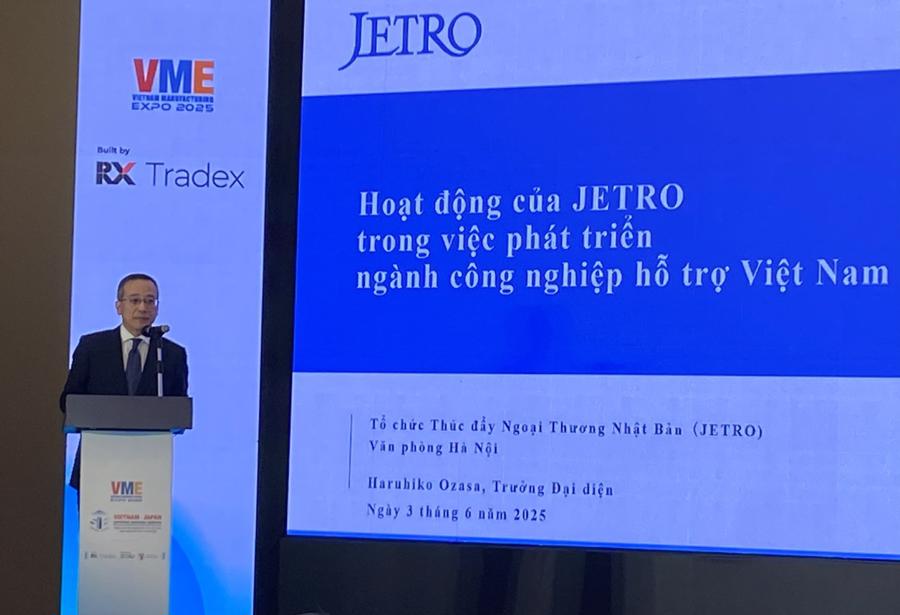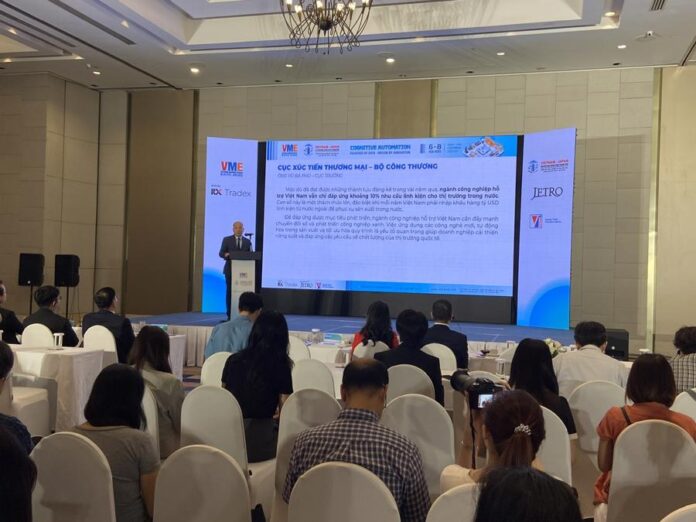To strengthen the connection between Vietnamese and Japanese supporting industries and promote domestic manufacturing, on June 3, 2025, the Vietnam Trade Promotion Agency (VIETRADE) under the Ministry of Industry and Trade, the Japan External Trade Organization (JETRO) – Hanoi Representative Office, and RX Tradex Vietnam jointly held a press conference and signed a cooperation agreement to organize the 17th Vietnam Manufacturing Expo (VME) and the 11th Vietnam-Japan Supporting Industries Exhibition (SIE) in Hanoi.
THE SUPPLY RATIO FOR JAPANESE COMPANIES REMAINS MODEST
Speaking at the event, Mr. Vu Ba Phu, Director of VIETRADE, said that by the end of 2024, Vietnam’s supporting industries had over 6,000 enterprises operating in textiles, automobile assembly, leather and footwear, mechanical engineering, and electronics.
The supporting industries have contributed to the development of several key industries in Vietnam, helping the country achieve a trade surplus of over $28 billion in 2024, up from $2 billion in 2017.
However, the supporting industries currently meet only about 10% of the domestic market’s demand for components. “This number is a big challenge, especially when Vietnam has to import billions of dollars worth of components from foreign countries each year to serve domestic production,” said Mr. Phu.
Japan is one of the leading investors in Vietnam in the fields of manufacturing and high technology. Specifically, in the past decade, the value of direct investment from Japan to Vietnam remained large, reaching $3.5 billion in 2024, ranking fifth in investment value.

Mr. Haruhiko Ozasa, Chief Representative of JETRO, said that according to JETRO’s latest survey, up to now, the localization rate of Japanese enterprises in Vietnam (including Japanese supporting industries enterprises in Vietnam and domestic enterprises in Vietnam) accounts for 36.6%, equivalent to Malaysia and the Philippines. In 2024, the depreciation of the yen contributed to an increase in the supply ratio from Japan (up 2.7 points from the previous year), leading to a decrease in the localization rate in Vietnam.
If Vietnamese enterprises are considered separately, the supply ratio to Japanese enterprises accounts for 15.7% of the total supply sources (down 1.5 points from the previous year). According to JETRO’s leader, this number is still very small and low and has been stable for the past 10 years. Compared to Indonesia, Thailand, and Malaysia, this ratio of Vietnamese enterprises is still limited and only equivalent to the Philippines.
The survey also showed that in 2024, up to 56.1% of Japanese enterprises operating in Vietnam intended to expand their investment within 1-2 years, a figure far exceeding the ASEAN average of 37.7%. Vietnam ranked second after India and Pakistan.
Moreover, 50.9% of these companies intended to increase procurement in Vietnam, the highest rate among ASEAN countries. By industry, enterprises in the fields of electrical and electronic equipment, textiles and garments, and machinery all expressed a high demand for expanding domestic supply.
VIETNAMESE SUPPLIERS NEED TO CREATE NEW COMPETITIVE ADVANTAGES
To increase the domestic localization rate, Mr. Vu Ba Phu said that the proactiveness of enterprises is the most important factor, along with government policies. Enterprises need to grasp international market trends and transform their management models and internal controls to meet international standards.
At the same time, they should proactively capture new trends in the world, such as digital transformation and green transition, to meet the requirements of foreign enterprises. The application of new technologies, automation in production, and optimization of processes are essential for enterprises to improve productivity and meet international market quality requirements.
According to JETRO’s leader, to continue expanding their business operations, Japanese enterprises need improvements in Vietnam’s investment and business environment, creating more favorable conditions for enterprises to ensure profit growth. One of the critical factors in increasing profits is enhancing the localization rate.

“Japanese enterprises invest and do business in Vietnam with diverse and multi-category production capabilities. Still, if they have to import components and parts from foreign countries and Japan, it is difficult to improve costs. Therefore, improving domestic procurement is one of the critical factors in reducing costs for enterprises,” said Mr. Haruhiko Ozasa.
So, what should Vietnamese enterprises do to meet the increasing demand for domestic supply from Japanese enterprises? According to Mr. Haruhiko Ozasa, it is essential and necessary to further develop the supporting industries.
“We expect Vietnam’s digital transformation and information technology application,” emphasized Mr. Haruhiko Ozasa, adding that there are two areas in which Japan expects Vietnamese suppliers to excel: information technology and digital transformation. Vietnam produces 50,000 information technology engineers each year, a high figure compared to the world, and this is a significant potential resource.
On the other hand, in the manufacturing industry, digital transformation is also being actively implemented. For example, some enterprises have applied IoT to visualize all production processes or used AI to eliminate defective and substandard products.
“Vietnam has a strong information technology sector with abundant human resources. Integrating information technology into the manufacturing industry will create new advantages, strengths, and competitive capabilities for Vietnamese supporting industries,” Mr. Haruhiko Ozasa said confidently.
The 17th Vietnam Manufacturing Expo (VME) and the 11th Vietnam-Japan Supporting Industries Exhibition (SIE) will take place from August 6-8, 2025, at the Hanoi L.C.E. Exhibition Center, expected to attract more than 200 enterprises from over 10 countries and over 10,000 specialized visitors.
VME and SIE 2025 are not merely trade promotion events but also tools to foster the development of the supporting industries ecosystem, create high-quality jobs, and enhance Vietnam’s position in the global value chain.
This year’s exhibitions will focus on critical solutions such as digital transformation, flexible automation, zero-emission manufacturing, and digital supply chains – factors considered vital for the future of Vietnam’s manufacturing industry.
“KienlongBank Chairman: AI Tellers Bring Banking to Remote Communities”
KienlongBank, a leading digital-first bank, is revolutionizing the industry with its innovative approach to banking. The bank’s ecosystem of digital products and services is impressive, but it’s the introduction of their unique AI Teller that steals the show. This cutting-edge technology takes center stage at the 2025 Banking Digital Transformation Event, showcasing KienlongBank’s commitment to delivering personalized and specialized financial services to each customer.
Revolutionizing the Way Vietnamese Businesses Operate: Lotus Chat for Work is Here with Exciting New Features
Lotus Chat for Work is set to launch online on June 4, 2025. Users will also have the opportunity to engage in a direct dialogue with Mr. Nguyen The Tan – CEO of VCCorp, the company directly developing Lotus Chat.
Unlocking the ‘New Goldmine’: Banks’ Astonishingly Swift Disbursement Processes
“The vast majority of small and micro-businesses, a staggering 97%, were once unable to access credit without collateral. However, through the power of data, which has become a ‘goldmine’, banks have revolutionized the lending landscape. By effectively mining and leveraging this data, banks now consider it as good as a physical asset for collateral, opening up a world of opportunities for these businesses to secure loans.”
“The Techcombank Strategy for the New Accelerated Phase: Aim High, Keep it Real.”
“Techcombank is embarking on a new phase of accelerated growth with a series of ambitious strategies. The bank has shared its plans, which include the IPO of TCBS, venturing into the digital asset market, establishing a life insurance company, enhancing its AI and data capabilities, and seeking strategic partnerships. These moves highlight Techcombank’s aspiration to lead the ‘digital ecosystem connectivity’ game in Vietnam.”




















